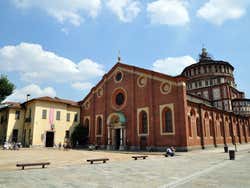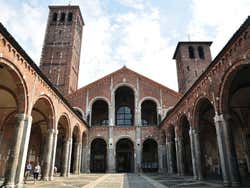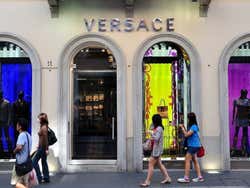
History of Milan
Milan was in the hands of Celts, Romans, Goths, Lombards, Spaniards and Austrians before becoming Italy's industrial and commercial capital as well as sharing the title of world fashion capital with Paris.
The beginning
The city of Milan was founded around 400 BC by the Insubres, a Gaulish population that lived on the north side of the River Po.
The Romans conquered the settlement in 196 BC and renamed it Mediolanum, meaning 'sanctuary' due to its strategic location between important commercial routes, as well as topography which allowed the Romans to defend themselves from the Germanic tribes.
Rome controlled Gallia Cisalpina (a Roman province) from Mediolanum and in 15 BC, Emperor Augustus declared the town capital of the Transpadania region.
Towards the third century, Milan became the capital of Italia annonaria (the north of Italy). The Roman Empire was divided into East and West and Maximian was made ruler of the Western Roman Empire, with Milan his base. An agreement called the Edict of Milan was signed in 313 AD in which the Western Roman Emperor Constantine I made Christianity legal. In 374 AD, St Ambrose was named bishop of Milan by popular acclamation, and during the fourth century, Ambrose was a very influential figure in Christianity.
Throughout this period threatened the North of Italy was threatened by barbarians from the Danube and the Alps. Following the city's sacking by the Visigoths in 402, the western capital was moved from Mediolanum to Ravenna, and in 452, the Huns too sacked Milan. As the power of the German tribes over the Western Roman Empire grew, changes were seen in Milan, and in the summer of 569 the Lombards, a Teutonic tribe who today give their name to the region conquered the city, bringing an end to Roman rule.
From the Middle Ages to the Duchy of Milan
Milan remained under Lombardian control until the town was seized by the Franks and Charlemagne in 774 when the Carolingian Empire controlled from modern-day France to Germany and Italy. It was seen as the successor to the Western Roman Empire with Charlemagne crowned emperor in Rome by Pope Leo III in an effort to revive the Roman Empire in the west during a vacancy in the throne of the Eastern Roman Empire. During this period, characterised by infighting and competition between the Holy Roman Emperor and the Roman Pope (the Holy Roman Empire had established their own, Avignon Pope in opposition to the Vatican) for influence in Italy, the Arabs controlled the Mediterranean and Milan prospered as a centre of trade, benefiting from the growth of trade between the east and the west, across the Adriatic Sea.
Following the precedent set by the crowning of Charlemagne, following the dissolution of the Carolingian Empire the "Holy Roman Empire", a collection of largely German territories became the dominant political force in Europe for many hundreds of years. In 961 Otto I of Germany invaded the Kingdom of Italy including Milan, conquering it and a year later establishing himself as Over the following centuries, and until 1266, the area was continually under contest between civil and religious powers. During the eleventh century, the government was no longer controlled by the count, but by the archbishop. Under the influence of Archbishop Aribert of Milan, the church of Milan became extremely powerful thanks to their loyalty towards Conrad II, Holy Roman Emperor.
Beginning with Otto I of Germany and ending with Napoleon, Milan became the city where many emperors of the Holy Roman Empire were crowned with the Iron Crown of Lombardy. During the eleventh century, Milan witnessed the struggles between the Lords, Knights and bourgeois families, which joined forces to crush a popular movement that had been disappointed by the withdrawal of Emperor Henry II’s reform policy and approach to the high Milanese clergy.
The high society of Milan who elected the consuls each year was aided by the Council of Credenza, to make these consuls Advisors of the Bishop in order to get rid of the ecclesial power (by the end of the twelfth century).
During the twelfth century, Milan had thousands of workers and was extremely wealthy. During this period, the nobles and the plebeians were constantly struggling for power. In 1198, there was a rupture between the various inhabitants of Milan and the popolani (plebeians) set up their own council of trust called “Credenza di Sant’ Ambrogio”.
The city was destroyed in 1162 by Frederick I Barbarossa. He took advantage of the internal and external struggles against neighbouring provinces to impose his sovereignty upon Milan. The Milanese rebelled against the emperor with the help of the Lombard League and defeated Barbarossa at the battle of Legnano. After this, the Peace of Constance was signed in 1183 and Milan became a duchy, with the ability to elect its own magistrates, giving it a degree of independence.
The internal struggles for domination of Milan continued during the following centuries. In the thirteenth century, the Torriani and the Guelphs (supporters of the Pope) and anti-Visconti families took the lordship of Milan, against the Visconti and the Ghibellines (supporters of the Holy Roman Emperors).
In 1311 King Henry sold the title of imperial vicar of Milan to Matteo I Visconti and unseated the Torriani, and by 1317, he had become lord general of Milan and his power spread throughout the north of Italy.
The fourteenth to the eighteenth century: The Duchy of Milan
The Duchy of Milan was a region of Milan that became extremely important financially and politically. It was the great power of the north of Italy during the Middle Ages.
The territory of Milan expanded under the reign of the first Duke of Milan, Gian Galeazzo Visconti, in 1385 with the annexation of Verona, Vicenza, Padua, Pisa, Persua and Bologna. The Duchy of Milan was created in 1395 when Galeazzo Visconti bought a diploma from King Wenceslaus for 1,000 florins giving him the title of Duke of Milan - a client state within the Holy Roman Empire which included 26 towns and spanned from the hills of Montferrat to the Lagoons of Venice.
When the Visconti dynasty ceased to exist with the death of Filippo Maria in 1447, Milan was declared the Ambrosian Republic until 1450 when Francesco Sforza conquered the city and the House of Sforza succeeded the Visconti. Almost immediately, Francesco Sforza, a mercenary leader who had fought often for Milan, was proclaimed Duke with his marriage to Filippo Maria's illegitimate daughter Bianca Maria Visconti tying him to the title. His reign was known as moderate and modernising, making his court a centre of Renaissance thought, and bringing to the city many buildings which still stand today, founding the Ospedale Maggiore, restoring the Palazzo dell'Arengo and building the Naviglio d'Adda, a canal to bypass the rapids on the Adda River. This work was continued by Ludovico Maria Sforza (the fourth son of Francesco I Sforza and Duke of Milan between 1494 and 1499). He was a patron of Leonardo da Vinci and other renowned artists, inviting them to paint in Milan.
Milan was conquered by the King of France Louis XII in 1499 and claimed the Duchy for himself (his grandmother had been a member of the Visconti family). The French maintained power in Milan until 1529, with a short break between 1512 and 1515 when the Swiss defeated the French at the Battle of Novara. In 1515, Francis I invaded the area again, but The French were defeated by Spanish Holy Roman Emperor Charles V and Milan was made part of Habsburg Spain. Francesco II Sforza, the last of the Sforza line was appointed its duke, always under Spanish control, fighting at the Battle of Bicocca on the side of the emperor, but in 1526 changed sides, joining French, Papal and Florentine forces in the League of Cognac, aiming to drive Charles from Italy, and ending up besieged in Sforza castle.
Francesco II Sforza died without any heirs in 1535 and the Duchy of Milan became part of the Spanish Empire, although the French claimed the Duchy, leading to more wars between the Spanish and French. In 1556, Charles V abdicated in favour of his son Philip II.
From 1540 until 1714, the Kings of Spain dominated the Duchy of Milan and the city of Milan was considered a provincial capital. It became a wealthy area thanks to the richness of the land, which was irrigated by the River Po, the opening of the Gotthard tunnel, the wool and silk industries, the minting of gold coins and a successful weapons industry. During the fourteenth century, Milan had 100.000 inhabitants and reached 200.000 by the end of the fifteenth century.
In 1713 Spain relinquished the Duchy of Milan to Austria by the Treaty of Utrecht, although it tried to reconquer it twenty years later. The Austrians reformed the city, modernising it after years of neglect by the Spaniards. In 1797, Napoleon invaded Milan and the rest of Italy and declared the city the capital of the Cisalpine Republic.
Nineteenth century
From 1799 until 1802, power was restored to Austria until January 1802, when Napoleon became president of the Republic of Italy and in 1805, he was crowned king of Italy in Milan, although this only refers to a part of northern and eastern Italy as we know it today.
The Congress of Vienna returned the city to Austrian control in 1815 and Milan became the capital of Lombardy.
From here, Milan became one of the main focuses of Italian nationalism. In 1848, the Milanese rebelled against Austrian rule, during the battle of “Five-Days”, from 18 to the 22 of March. Nevertheless, Milan was still subject to the Austrian monarchy until 1859.
That same year the Austrians left Milan, and the city and Lombardy were incorporated into the Kingdom of Sardinia. A few years later Milan became part of the Kingdom of Italy with the unification of Italy. The capital of Italy was moved to Florence and then back to Rome, although the financial capital of the country was always considered Milan.
Present day Milan
Mussolini founded the fascist party in Milan in 1919. His followers created numerous strikes, harassed certain sectors of the population, like the liberals, and assaulted the workers’ newspapers, repressing the worker’s committees in Milan during the early years.
In 1944, anti-fascist groups in the north of Italy organized a Northern Liberation Committee and Milan was freed from German troops in 1945 thanks to a general strike, which lasted several days. After World War II, Milan became a prosperous industrial city with a large working class.
Presently, Milan is the second largest city in Italy and the wider Milan metropolitan area has a population of over 8 million people. It is Italy’s main industrial, financial and commercial centre and along with Paris, is Europe’s fashion and design capital.



